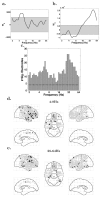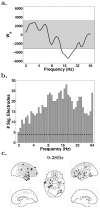Theta and gamma oscillations during encoding predict subsequent recall
- PMID: 14645473
- PMCID: PMC6740970
- DOI: 10.1523/JNEUROSCI.23-34-10809.2003
Theta and gamma oscillations during encoding predict subsequent recall
Abstract
Electrophysiological and hemodynamic measures of human brain activity have been shown to distinguish between episodes of encoding items that are later recalled versus those that are not recalled (Paller and Wagner, 2002). Using intracranial recordings from 793 widespread cortical and subcortical sites in 10 epileptic patients undergoing invasive monitoring, we compared oscillatory power at frequencies ranging from 2 to 64 Hz as participants studied lists of common nouns. Significant increases in oscillatory power during encoding predicted subsequent recall, with this effect predominantly in the 4-8 Hz (theta) and 28-64 Hz (gamma) frequency bands. Sites exhibiting increased theta activity during successful encoding were clustered in right temporal and frontal cortex, whereas those exhibiting increased gamma activity appeared bilaterally at widespread cortical locations. These findings implicate theta and gamma oscillatory activity, across a widespread network of cortical regions, in the formation of new episodic memories.
Figures



References
-
- Brewer JB, Zhao Z, Desmond JE, Glover GH, Gabrieli JD ( 1998) Making memories: brain activity that predicts how well visual experience will be remembered. Science 281: 1185-1187. - PubMed
-
- Caplan JB, Madsen JR, Raghavachari S, Kahana MJ ( 2001) Distinct patterns of brain oscillations underlie two basic parameters of human maze learning. J Neurophysiol 86: 368-380. - PubMed
-
- de Araujo DB, Baffa O, Wakai RT ( 2002) Theta oscillations and human navigation: a magnetoencephalography study. J Cognit Neurosci 14: 70-78. - PubMed
-
- Debener S, Herrmann CS, Kranczioch C, Gembris D, Engel AK ( 2003) Top-down attentional processing enhances auditory evoked gamma band activity. NeuroReport 14: 683-686. - PubMed
Publication types
MeSH terms
Grants and funding
LinkOut - more resources
Full Text Sources
Other Literature Sources
Medical
